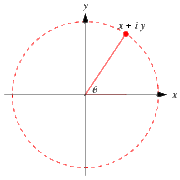Definition
The complex numbers are the field C of numbers of the form x+iy, where x and y are real numbers and i is the imaginary unit equal to the square root of -1, sqrt(-1).
Operations -- Credit to wikipedia
Complex numbers are added, subtracted, multiplied, and divided by formally applying the associative, commutative and distributive laws of algebra, together with the equation i 2 = −1:
- Addition: $ \,(a + bi) + (c + di) = (a + c) + (b + d)i $
- Subtraction: $ \,(a + bi) - (c + di) = (a - c) + (b - d)i $
- Multiplication: $ \,(a + bi) (c + di) = ac + bci + adi + bd i^2 = (ac - bd) + (bc + ad)i $
- Division: $ \,\frac{(a + bi)}{(c + di)} = \left({ac + bd \over c^2 + d^2}\right) + \left( {bc - ad \over c^2 + d^2} \right)i\,, $
where c and d are not both zero.
It is also possible to represent complex numbers as ordered pairs of real numbers, so that the complex number a + ib corresponds to (a, b). In this representation, the algebraic operations have the following formulas:
- (a, b) + (c, d) = (a + c, b + d)
- (a, b)(c, d) = (ac − bd, bc + ad)
Since the complex number a + bi is uniquely specified by the ordered pair (a, b), the complex numbers are in one-to-one correspondence with points on a plane. This complex plane is described below.


